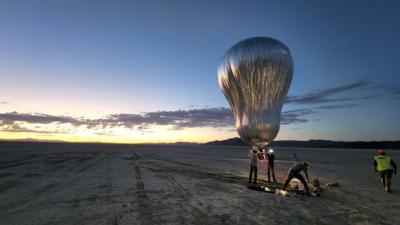Thu, Oct 13, 2022
Atmospheric Assestment System in Development for Venutian Exploration
The Jet Propulsion Laboratory completed the first of a battery of test flights for their prototype aerial robotic balloon.

The system is hoped to help uncover atmospheric conditions on the planet Venus, deploying the balloon into the intense heat, pressure, and corrosive gases found in its environment. The balloon is a part of a concept that pairs it with an orbiting platform outside the atmosphere. The duo would allow the orbiting portion to function as a communications relay while allowing the robotic balloon, or "aerobot" , to descend into the atmosphere proper and act as a submerged analysis platform.
The idea is promising enough for the JPL to begin work on preliminary designs that would see the aerobot make humanity’s best observation of Venus in decades, following up on a balloon-borne survey done underthe Soviet’s Vega mission in 1985. Those balloons lasted only 46 hours before losing power, a record that should be handily outperformed with modern technology - provided, of course, that they’re hardy enough to survive. The ultimate goal for NASA is to create an aerobot that can travel by riding the Venusian winds, circumnavigating the planet for at least 100 days while monitoring the planet with as many sensors as they can pack aboard.
The Jet Propulsion Lab tested the general concept with the assistance of the Near Space Corporation to assess the feasibility of a smaller 1/3 scale demonstrator over Nevada's Black Rock Desert. The test saw the silvery aerobot ascent to 4,000 feet, roughly equivalent to the atmospheric conditions found at 180,000 ft AGL on Venus. The prototype appears to have been a success, ascending and holding altitude before coming back down to earth with the trademark grace of lighter-than-air aircraft.
“We’re extremely happy with the performance of the prototype. It was launched, demonstrated controlled-altitude maneuvers, and was recovered in good condition after both flights,” said robotics technologist Jacob Izraelevitz, who leads the aerobot's development as the JPL principal investigator over flight testing. “We’ve recorded a mountain of data from these flights and are looking forward to using it to improve our simulation models before exploring our sister planet."
More News
From 2023 (YouTube Version): Legacy of a Titan Robert (Bob) Anderson Hoover was a fighter pilot, test pilot, flight instructor, and air show superstar. More so, Bob Hoover was an i>[...]
Get The Latest in Aviation News NOW on Instagram Are you on Instagram yet? It's been around for a few years, quietly picking up traction mostly thanks to everybody's new obsession >[...]
Aero Linx: B-52H Stratofortress The B-52H Stratofortress is a long-range, heavy bomber that can perform a variety of missions. The bomber is capable of flying at high subsonic spee>[...]
Altimeter Setting The barometric pressure reading used to adjust a pressure altimeter for variations in existing atmospheric pressure or to the standard altimeter setting (29.92).>[...]
"Knowing that we play an active part in bettering people's lives is extremely rewarding. My team and I are very thankful for the opportunity to be here and to help in any way we ca>[...]
 Classic Aero-TV: Remembering Bob Hoover
Classic Aero-TV: Remembering Bob Hoover ANN FAQ: Follow Us On Instagram!
ANN FAQ: Follow Us On Instagram! ANN's Daily Aero-Linx (05.15.24)
ANN's Daily Aero-Linx (05.15.24) ANN's Daily Aero-Term (05.15.24):Altimeter Setting
ANN's Daily Aero-Term (05.15.24):Altimeter Setting Aero-News: Quote of the Day (05.16.24)
Aero-News: Quote of the Day (05.16.24)



